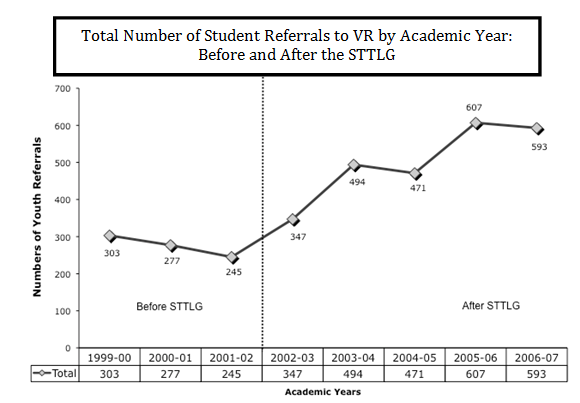My name is David Brewer, Senior Extension Associate for the Employment and Disability Institute at Cornell University. Professional development isn’t always about listening to a presenter, watching a slide presentation, and asking a few questions. True learning with measurable student impact in mind involves relationship building
Lesson Learned:
- Creating our own Evidence. You don’t have to be a trained researcher to create evidence for use in improving services for students. The following example highlights how a diverse group of stakeholders can collect data, identify a common area of concern, set targets, plan activities, and reflect on results towards future planning and improvements. The Southern Tier Transition Leadership Group (STTLG) was created in 2001 to improve the number and quality of youth referrals to the New York State Vocational Rehabilitation Agency (VR) for services leading to employment and postsecondary outcomes. This group, which continues to meet, is made up of VR senior staff, school district representatives, State Education Department officials, a Transition Specialist, and other agency representatives. Three times a year, the regional VR office provided youth referral data by school district to measure progress and plan activities. Below are the annual increases before (245 students 2001-02) and five years after STTLG began meeting (593 in 2006-07).
- Looking at these numbers as a trend line, the three-year average of student referrals to VR before the STTLG was 275 students. For the three years beginning in 2004-05, the average increased to 557 students – a 103% increase.
Hot Tip:
- Shared Learning. These sustainable results were achieved without grant funding, but with shared ownership of both process and results. This is not about VR referrals. This is a description of a shared learning and improvement process between professionals, resulting in measurable change for transitioning students.
- Applying Lessons Learned. The purpose behind this initiative was to improve organizational capacity through a process of emergent learning. Given the complexities of improving student achievement and post-school outcomes, finding the right answers is a collaborative process of reviewing data, setting targets, implementing research-based practices, learning from results — and applying lessons learned to future interventions. The process of emergent learning is a journey that requires a long-term commitment to measurable change.
Rad Resources:
- TransitionSource.org Designed to support educational programs and agencies to advance post-school outcomes of secondary students with disabilities.
New York State Program on Transition to Adulthood for Youth with Disabilities
The American Evaluation Association is celebrating Professional Development Community of Practice (PD CoP) Week. The contributions all week come from PD CoP members. Do you have questions, concerns, kudos, or content to extend this aea365 contribution? Please add them in the comments section for this post on the aea365 webpage so that we may enrich our community of practice. Would you like to submit an aea365 Tip? Please send a note of interest to aea365@eval.org. aea365 is sponsored by the American Evaluation Association and provides a Tip-a-Day by and for evaluator.


